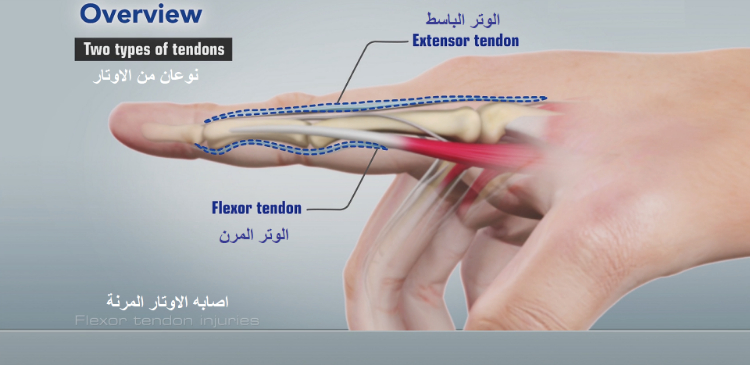Anatomy
Tendons are tissues that connect muscles to bone. When muscles contract, tendons pull on bones, causing parts of the body to move. Long tendons extend from muscles in the forearm and attach to the small bones of the fingers and thumb. Tendons are kept in place next to the bone by snug tunnels called tendon sheaths. The extensor tendons on top of the hand are used to straighten the fingers. The flexor tendons on the palm side of the hand are used to bend the fingers.
Description
A deep cut in the palm side of your hand, fingers, wrist or forearm is likely to damage or even sever the flexor tendons, which are quite close to the surface of the skin. Because tendons are under tension as they connect muscle to bone, the ends pull far apart when torn or cut, like a rubber band, making it impossible for the injured tendon to heal on its own. Without appropriate treatment, a flexor tendon injury can cause you to lose the use of your fingers, thumb or entire hand. A cut in this area of the hand may also involve important nerves and blood vessels, resulting in numbness or inadequate blood supply. Urgent surgery may be necessary.
Occasionally, flexor tendons may be partially cut or torn. With a partial tendon tear, it may still be possible to bend your finger, but not completely. These types of tears can be difficult to diagnose.
Symptoms
The most common signs of a flexor tendon injury include: a cut or open injury on the palm side of your hand, often where the skin folds as the finger bends; inability to bend one or more joints of the finger; pain when the finger is bent; tenderness along the finger on the palm side of the hand; and numbness in the fingertip.
Causes
In addition to cuts, certain sports activities can cause flexor tendon injuries. Participants of football, wrestling, rugby and other similar sports may suffer "Jersey finger," where the tendon is pulled off the bone. During rock climbing and other activities that require extensive arm and hand strength, the tendons and/or sheaths may be stretched or torn. Certain health conditions (rheumatoid arthritis, for example) weaken the flexor tendons, making them more susceptible to tearing. Without warning or injury, a person may realize the finger no longer bends, without knowing how it happened.
Immediate First Aid
If you suffer a serious cut to your hand or fingers, apply ice immediately. Tightly wrap your hand with a clean cloth or bandage to slow down the bleeding, and keep your hand elevated above your heart. See a doctor as soon as possible for treatment, which may include a tetanus shot or antibiotics to prevent infection. Whenever your fingers are injured, even if the skin is not broken, it is very important to be examined by a physician. This is especially true if the finger is jammed and you cannot bend or straighten your fingertip.
Diagnosis
In order to determine the extent of your injury, your physician will perform an examination that may include evaluating the strength of your fingers as well as your ability to bend and straighten them. Testing your hand for sensation and blood flow to the fingers will help verify if any nerves or blood vessels have also been injured. An X-ray may also be necessary to see if there isany damage to the bone.
Nonsurgical Treatment
Following the examination, your physician may place your hand in a splint for protection prior to surgery. If your tendon is partially torn, depending on the injury, your orthopaedic surgeon may recommend a nonsurgical treatment that includes the same splinting and exercise programs used for surgery patients.
Surgery
Because the ends of a torn or severed tendon no longer touch, in most cases, it must be surgically repaired to heal properly. Typically, the sooner surgery is performed the better the outcome, so it is usually performed no later than 10 days after the injury. If the blood flow to your hand or finger is restricted, however, your orthopaedic surgeon may schedule your surgery immediately.
- Surgical procedure—Tendons can tear in a variety of ways, including straight across, at an angle, or pulled off of the bone. There are various methods your surgeon may use to m the repair, but all involve special sutures, or stitches. Surgery is usually performed on an outpatient basis, allowing you to return home the same day. After the surgery, your doctor will place your fingers and wrist in a bent position to keep minimal tension on the repair, then apply dressing and splint to protect the repair and limit movement as the tendon heals.
Recovery
It can take up to 2 months before the repair heals and your hand is strong enough to use without protection. Another month or so may be needed before your hand can be used with any force. Soon after surgery, you will begin physical therapy, performing specific exercises to help you gradually regain motion and function. Stiffness is common after surgery, but usually responds well to therapy. Wearing your splint and following your therapist's instructions are as important to your recovery as the surgery itself.
Long-Term Outcomes
Flexor tendon surgery typically results in a good return of function and high patient satisfaction. However, this injury can be challenging to treat. Despite extensive therapy, some patients experience long-term stiffness. Occasionally, a second surgery to free up scar tissue is required to help the patient regain motion.

